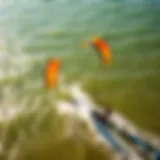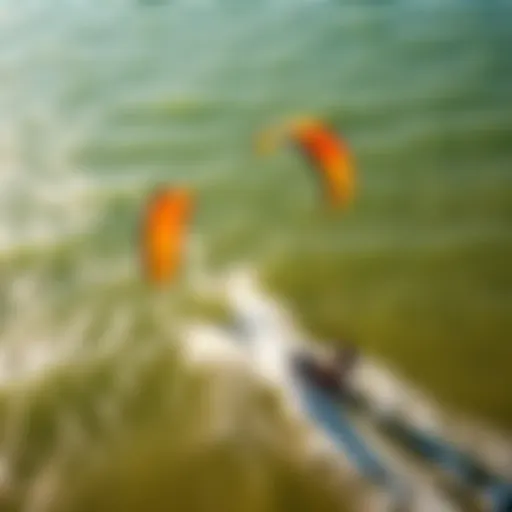Kite Surfing in Oahu: An In-Depth Exploration
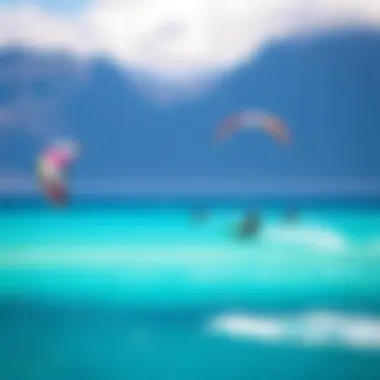
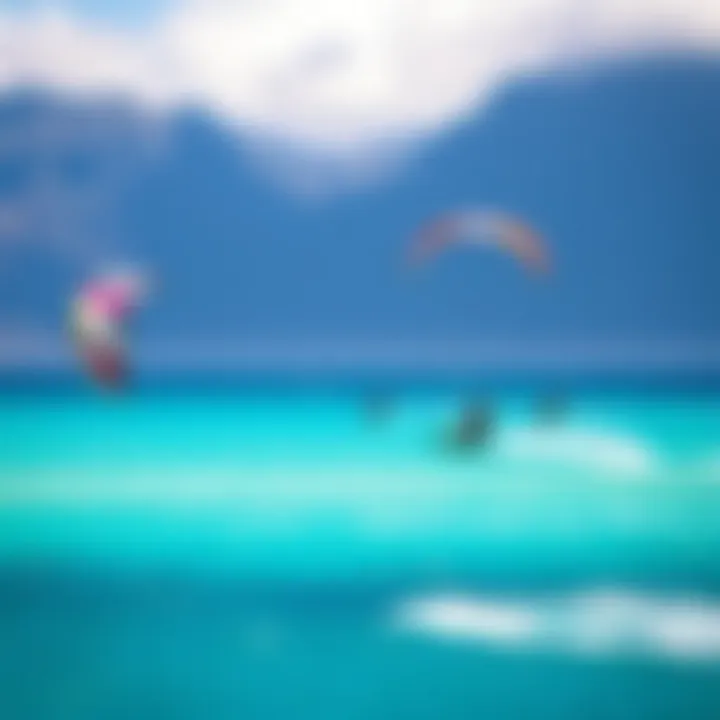
Intro
Kite surfing in Oahu isn't just a sport; it’s a dance with nature, where skill meets the elements. On this vibrant Hawaiian island, the sky becomes a canvas painted with colorful kites, bobbing on the waves like butterflies. Surfers of all levels flock here, drawn by the promise of perfect wind and enchanting sunsets.
For those looking to glide across the aqua blue waters, understanding the nuances of gear, technique, and safety can make all the difference. This guide delves into the essentials of kite surfing in Oahu, breaking down everything from choosing the right equipment to exploring key locations that every kiteboarder should visit. With layers upon layers of local expertise tucked in, this exploration aims to equip both budding enthusiasts and seasoned veterans.
While it’s easy to get swept away by the allure of a windy day on the water, one cannot overlook the responsibility that comes with this thrilling sport. Respect and knowledge of the local ecosystems add depth to the experience, reminding kite surfers to tread lightly as they enjoy the unforgettable landscapes the island offers.
As we embark on this kite surfing odyssey, we’ll start with one of the most critical components: gear selection. After all, having the right equipment can mean the difference between a joyful glide and a challenging tumble.
Gear Selection
Kite surfing requires a special blend of equipment critical to safety and performance. Selecting the right gear is akin to a chef choosing the right knives; without the proper tools, success may be harder to achieve.
Types of Kites
At the heart of kite surfing lies the kite itself. Kites vary greatly in design and function:
- Inflatable Kites: Most popular among beginners and experienced riders alike, these kites are filled with air and provide excellent stability. They can handle obstacles and rough winds splendidly.
- C-Shape Kites: These are often favored by freestyle riders. Their design allows for fantastic maneuverability, perfect for jumps and tricks.
- Foil Kites: Less common in Oahu, but their lightweight and efficient design allows for smooth gliding. Ideal for lighter winds, they require a bit more finesse.
Choosing a kite often depends on the rider's weight, ability level, and the typical wind conditions one expects to encounter in Oahu’s coastal areas. Each style brings a different experience to the table, and thus it's vital to analyze one’s riding style before making a selection.
Choosing the Right Board
Like picking a pair of shoes, boards come in a variety of sizes and styles suited to different preferences:
- Directional Boards: These resemble surfboards and allow for carving through the waves, making them great for those looking to surf the swells.
- Twin-Tip Boards: More common for those focused on tricks and jumps, these boards can ride in both directions, offering greater versatility.
- Freestyle Boards: Designed with specific tricks in mind, they are lightweight and have a flexible construction to facilitate jumps and performances.
The ideal board will ultimately depend on one’s skill level and the type of riding they wish to undertake. A beginner may find a twin-tip board easier to manage, while an advanced rider might lean towards a directional board to explore the waves.
"The right gear is only the beginning; the journey in kite surfing requires practice, patience, and respect for the ocean."
Equipped with the proper kites and boards, kite surfers can now focus on developing their skills. This leads us into our next crucial area: skill development.
Prolusion to Kite Surfing in Oahu
Kite surfing in Oahu presents an exhilarating blend of thrill and skill, captivating both novices and seasoned riders alike. As the sport gains traction around the world, Oahu stands out as a prime locale for those wanting to harness the wind and waves. This article aims to elucidate the facets of kite surfing in this Hawaiian paradise, detailing not just the excitement it offers but also the important considerations that enhance the overall experience.
Understanding Kite Surfing
Kite surfing, a water sport that marries elements of surfing and flying, involves being pulled across the water by a specially designed kite. Whether you're gliding over the waves or performing aerial tricks, the essence of the sport lies in mastering control of the kite and board simultaneously. It's similar to balancing on a tightrope while being propelled by the wind, a dance of sorts with nature that demands focus, agility, and respect.
The thrill of kite surfing is hard to put into words. The rush of wind in your face, the splash of water as the board glides over the surface, and the feeling of weightlessness during jumps create a compelling experience. But it's not all play; successful kite surfing requires understanding wind dynamics, ocean currents, and safety measures critical to enjoying the sport.
Oahu as a Kite Surfing Hub
In the world of kite surfing, Oahu is not just another spot on the map; it's often regarded as a mecca. Why? Several factors set this Hawaiian island apart. There’s the year-round warm weather, consistent wind patterns, and various beaches accommodating all levels of expertise. In Oahu, both the beginner, learning the ropes, and the advanced rider, looking to perfect tricks, can find their niche.
The island's diverse coastline also creates a spectrum of wave conditions. For instance, spots like Kailua Beach and Lanikai Beach offer gentler waves for learning and honing basic skills, while the North Shore's Sunset Beach challenges even the most experienced riders with powerful swells.
"Kite surfing isn't just about the ride; it's about the culture, the community, and the backdrop of one of the most beautiful places on Earth."
The community here is vibrant and welcoming, with local schools providing guidance for newcomers. This is significant not only for improving skills but also for fostering a sense of belonging among kite surfers.
As this article unfolds, we will discuss geographical advantages, essential gear, safety considerations, and the environmental implications of kite surfing in Oahu. These elements intertwine with the kiting experience, enhancing its richness and ensuring a balanced approach to the sport.
Geographical Advantages of Oahu
Oahu's geographical features play a pivotal role in establishing it as a premier destination for kite surfing. Understanding these factors is essential for anyone looking to navigate its waters. With the right wind and water dynamics, kite surfing can become not just a sport, but an exhilarating experience that encompasses the beauty of nature and the thrill of adventure.
Wind Patterns and Conditions
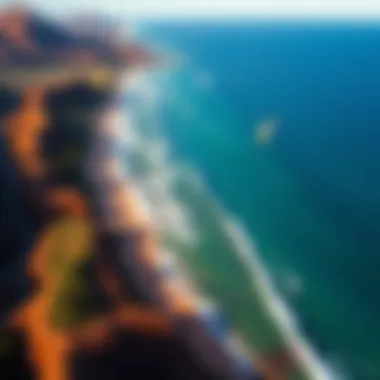
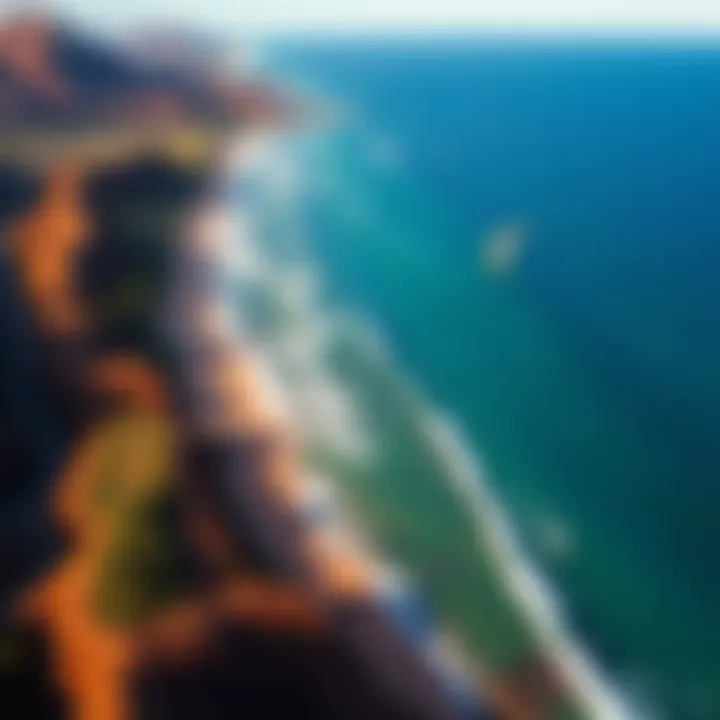
Oahu’s wind patterns are the lifeblood of kite surfing. Trades winds here typically usher in consistent breezes that can vary in strength, usually ranging from 10 to 25 knots. These steady winds come from the northeast, making the island a blessed site for kite surfers.
In the summer months, you might find the winds becoming a bit more mellow, allowing for a more relaxed session on the water. On the flip side, winter can bring in gustier conditions, perfect for those seeking a little more adrenaline. The predictable nature of these winds means that surfers can plan their outings with some degree of certainty.
"The trades, my friend, are like the regulars at a bar — you can count on them to show up!"
Understanding how these winds interact with various beach and water conditions is crucial. For instance, the wind can shift slightly according to topographical influences. If you’re kite surfing at Kailua Beach, the surrounding mountains might create some turbulence; however, the overall conditions tend to remain favorable.
Beach and Water Characteristics
The beaches of Oahu are as diverse as they come, each offering distinct features that enhance the kite surfing experience. Take Kailua Beach, for instance; its soft, sandy expanses and relatively shallow waters make it ideal for beginners. The forgiving nature of the seabed here means that any wipeouts are less likely to lead to injury, getting you back on your board in no time.
On the other side of the island, Lanikai Beach presents a postcard-perfect setting with its clear azure waters and gentle waves. The appeal of this beach extends beyond aesthetics — it also allows for smoother rides, making it a favorite amongst intermediate kite surfers looking to practice their skills.
Here are some characteristics to consider regarding Oahu’s beaches:
- Sandy Bottoms: Many of Oahu's beaches have soft bottoms, making falls less daunting.
- Wave Conditions: From small swells to larger surf, the diversity in wave activity allows for different skills to flourish.
- Scenic Backdrops: Iconic vistas enhance your riding experience, immersing you in the island's natural beauty.
Each beach, from the tranquil waters of Lanikai to the more challenging waves on the North Shore, provides a unique canvas for kite surfers to express themselves. Thus, selecting the right spot based on one's skill level and desired conditions becomes paramount for an enjoyable kite surfing experience.
In summary, Oahu’s geographical advantages are vast and varied, contributing significantly to its status as a kite surfing haven. From dependable wind patterns to picturesque beaches, these elements combine to offer both novice and experienced surfers an unmatched experience on the water.
Top Kite Surfing Locations in Oahu
Finding the right spots for kite surfing can be the difference between an unforgettable experience and a challenging day on the water. Oahu, with its lush landscapes and ideal wind patterns, offers numerous beaches that cater to both novice and experienced kiteboarders. Understanding the unique characteristics of each location can help enthusiasts maximize their time spent riding the waves, ensuring they not only have fun but also stay safe. In this section, we’ll explore three prime locations: Kailua Beach, Lanikai Beach, and the famed North Shore at Sunset Beach.
Kailua Beach
Kailua Beach is often heralded as one of the premier kite surfing locations on the island. The beach boasts steady winds and crystal-clear waters, making it a playground for both beginners and seasoned riders alike. The trade winds that sweep through the area typically blow consistently throughout the year, offering perfect conditions for a thrilling session.
For visitors, Kailua Beach provides several amenities that enhance the kite surfing experience:
- Easy Access: The beach is equipped with ample parking and restrooms, making it convenient for a quick session or a full day on the water.
- Community Vibe: Local kite surfing schools frequent the area, allowing newcomers to take lessons and get acquainted with the sport under the guidance of experienced instructors.
- Safety Considerations: The beach has designated zones for kite surfers, ensuring that riders maintain a safe distance from other beachgoers.
Overall, Kailua Beach is ideal for those looking to hone their skills or enjoy a laid-back session.
Lanikai Beach
Just a stone's throw from Kailua Beach, Lanikai Beach is often described as one of the most stunning beaches in the world, and it certainly doesn’t disappoint when it comes to kite surfing, either. The beach is known for its picturesque setting with soft, white sand and the Mokulua Islands in the background.
What makes Lanikai unique also comes with its own set of challenges. Here are a few factors to keep in mind:
- Wind Variability: While the winds can be fantastic, they can also be unpredictable at times. Planning your kiting sessions around the best wind forecasts is essential.
- Limited Space: With its beauty comes popularity. The beach can get crowded, especially on weekends, which may require kite surfers to be vigilant and aware of their surroundings.
- Environmental Appeal: Kite surfers at Lanikai should take care to respect the natural surroundings. Lanikai is renowned for its beauty, and preserving it is everyone’s responsibility.
Lanikai Beach serves as a spot that blends beauty with excitement, making it a must-visit for any kiteboarding enthusiast.
North Shore - Sunset Beach
When one thinks of Hawaii, the North Shore likely comes to mind, famous for its massive waves and laid-back atmosphere. Sunset Beach is a captivating location known for its stunning sunsets that serve as a backdrop for a thrilling day of kite surfing. While it’s a hotspot for experienced surfers, it also holds its acclaim among kite enthusiasts.
Here are a couple of noteworthy aspects about Sunset Beach for kite surfers:
- Challenging Conditions: The waves can be quite intense, especially during the winter months. This makes it a perfect playground for advanced riders looking to test their skills and push their limits.
- Community Events: Throughout the year, Sunset Beach hosts various competitions and community events, fostering a spirited atmosphere among riders and spectators alike.
- Wind Patterns: The North Shore typically experiences afternoon breezes, making it a reliable spot for kite surfing during the warmer months.
While Sunset Beach might not be as beginner-friendly as Kailua or Lanikai, it stands as a symbol of the adventurous spirit of kite surfing, inviting those willing to tackle its challenges.
Oahu’s beaches offer kite surfers not just locations to ride but also experiences to treasure, as the islands’ natural beauty meshes perfectly with the thrill of the sport. The surfer's journey through these diverse spots creates lasting memories and a deeper connection to the ocean.
Essential Gear for Kite Surfing
Kite surfing is not just about riding the waves; it’s also a dance between man, machine, and nature. The right gear can spell the difference between a thrilling adventure and a harrowing experience. Understanding the essentials of kite surfing gear is vital, especially for both novices and seasoned kiteboarders alike. The equipment directly impacts performance, safety, and overall enjoyment. Well-chosen gear can help you navigate Oahu’s variable conditions with confidence and ease.
Kites: Types and Selection
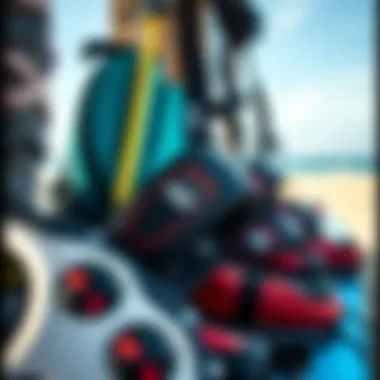
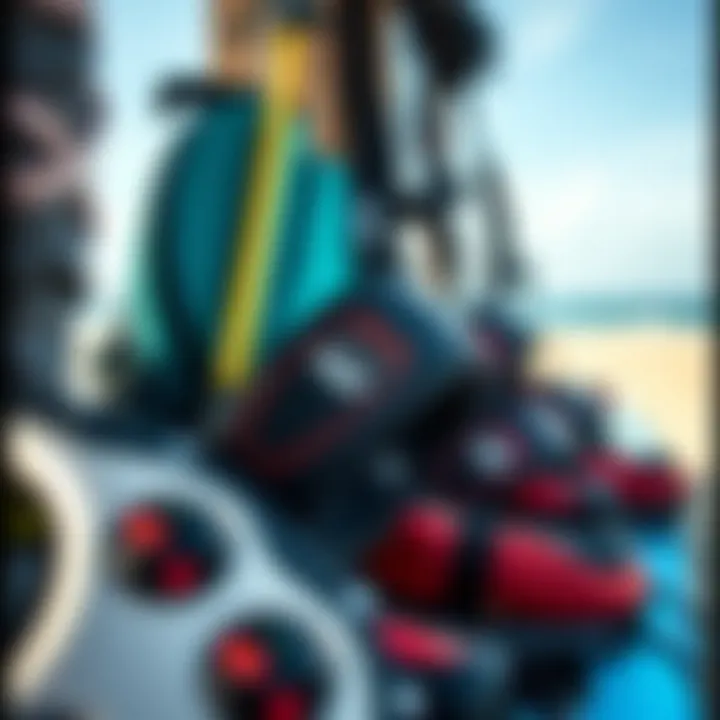
Selecting the right kite is akin to picking the right partner for a dance. Kites generally come in two main types: C-kites and bow kites. C-kites have a more profound curve with increased lift; they are typically more responsive, making them favored among speed freaks and tricksters. Many pros lean toward C-kites for their ability to perform stunts and jumps. On the flip side, bow kites offer easier relaunch and better low-end power. They've also got larger wind ranges, which makes them more forgiving for beginners.
Additionally, it’s important to consider the size of the kite. A bigger kite catches more wind, which is excellent for lighter winds, but it can be overwhelming in stronger winds. It's often advised to choose a kite that fits your weight and skill level. For instance, a kite between 7 to 9 meters works well for average riders in high winds, while beginners might find something between 10 to 12 meters more manageable.
Boards: Making the Right Choice
When it comes to boards, it often boils down to personal preference. It's essential to find a board that complements your style and meets the specific conditions you expect to encounter. Generally, boards can be categorized into two main types: twin-tip boards and directional boards. Twin-tip boards, which look like snowboard sides, are great for versatility and allow riders to tackle almost any condition, making them a staple for most beginner and intermediate kite surfers.
On the other hand, directional boards are more like surfboards. They’re typically utilized in surfing-oriented kiteboarding where you ride downwind. They can offer unique advantages, such as greater speed on waves, but require a different skill set.
Apart from type, board size is crucial. A larger board offers more surface area, giving you greater stability and easier upwind performance. However, a shorter board generally leads to better control and maneuverability. Riders need to think about their weight and the wind conditions when selecting an ideal board.
Safety Equipment and Accessories
Safety gear is not merely an option; it’s a necessity. Kite surfing can be unpredictable. Essential safety equipment includes a impact vest, which can protect your torso during falls, and a helmet for head injuries. Equally important is the kite leash, which serves as your lifeline, connecting you to the kite and enabling quick release in emergencies.
Other accessories worth considering are life jackets, especially if you're in robust conditions or are surfacing in unfamiliar waters. Some may also prefer wetsuits or drysuits for thermal regulation, depending on the local water temperatures. Remember, comfort equals control. If you're shivering, you're not going to ride your best.
"Fitting the right gear not only enhances your performance but ensures safety and enjoyment on the water."
In a nutshell, having the right gear shapes the overall kite surfing experience. A clear understanding of kites, boards, and safety equipment can significantly bolster one's performance on the stunning waters of Oahu.
Techniques to Master Kite Surfing
Kite surfing is not just about riding the waves and zipping through the air; it is an art that combines skill, balance, and intuition. Mastering kite surfing requires an understanding of various techniques that enhance not only your performance but also your safety and enjoyment of the sport. In Oahu, where the conditions can vary dramatically, honing these techniques becomes even more crucial for kiteboarders looking to elevate their game. This section delves into the essential maneuvers and advanced tricks that every kite surfer should grasp.
Basic Maneuvers
Starting with the basics can make all the difference in your kite surfing journey. These fundamental maneuvers serve as building blocks for more complex skills. Knowing how to execute them well sets you up for success and helps you feel more confident on the water.
- Launching and Landing the Kite: One of the first things to nail is how to get your kite up and down safely. Always check wind conditions before launching, and communicate clearly with your crew. Remember, one hand on the bar and the other controlling the kite ensures better control.
- Riding Upwind: This skill separates the pack. Riding upwind not only saves you energy but also allows you to enjoy longer sessions on the water. Use your edge to dig the board in and maintain a steady speed while keeping your kite positioned at 1 o’clock or 11 o’clock.
- Turning: Smooth turning is vital, whether you're transitioning from toe side to heel side or deciding to change direction. A simple way to practice is to focus on shifting your weight and looking where you want to go. An easy turn grabs attention, but a sharp turn can catch the eye of other surfers, so you’ll look good doing it too.
- Stopping: Learning to stop correctly is equally as crucial. Use your back foot to pressure the heel edge while pulling the kite down and toward the water. You'll come to a slow, steady halt, making you look like a seasoned pro.
Perfecting these basics will give you a solid foundation to build upon. Remember, practice makes perfect, and don’t shy away from seeking advice from local instructors or more experienced surfers.
Advanced Tricks and Styles
Once you’ve got the basics down and feel comfortable on the water, the time comes to leap into more complex tricks. These advanced styles and techniques not only challenge your abilities but also allow for creativity on the water. By mixing tricks, you can diversify your kite surfing experience.
- Jumping: A crowd favorite, jumps add a level of excitement to your kiting sessions. To execute a good jump, build speed before edging your board hard. Pull on the back hand to help your kite lift you off the water. Timing is everything—if you jump too early, you won’t get enough height, and if you jump too late, you risk losing control.
- Handle Passes: This trick showcases your skill and control. It involves passing the bar from one hand to the other while airborne. It takes practice, so don’t get discouraged if you don’t land it right away. Use the height gained from a good jump to facilitate the maneuver.
- Kiteloop: Known for its thrill factor, the kiteloop is where the kite loops in the air while you’re airborne. This trick requires confidence and precision. Ensure you're experienced enough to minimize risks involved with kite control while performing this trick as it can lead to significant crashes if not done properly.
- The Backroll: This fun trick involves rotating backward while in the air. Begin by initiating your jump, then lean back and look at the water to help spin. You can either do this with or without a grab for added style.
With hours of practice, these tricks can become a staple of your kite surfing. Remember, consistency is key.
"Good kite surfers aren’t born; they’re made through determination and practice."
Mastering these techniques not only enhances your skill but also deepens your appreciation for the sport. As you progress, you might find yourself being drawn to participate in local competitions or events, further integrating you into the vibrant kite surfing community in Oahu. So get out there, feel the wind, and let the waves guide you!
Safety Considerations in Kite Surfing
Kite surfing is undeniably thrilling, but it’s not all sunshine and waves. A prudent understanding of safety considerations is essential for anyone looking to enjoy this sport. Kite surfing in Oahu is celebrated for its vibrant conditions, yet those same elements can lead to unforeseen challenges if one isn't careful. Taking safety seriously can enhance not only your own experience but the safety of others in the area as well.
Understanding Local Conditions
Knowing the local conditions of the kite surfing spots in Oahu is crucial. The wind patterns and ocean currents can dramatically shift, affecting your ability to maneuver your kite effectively. For instance, the winds at Kailua Beach tend to be more predictable earlier in the day, turning more gusty as the heat rises. Understanding these variations will better equip you to make informed decisions about when and where to kite surf.
Also, pay attention to local weather forecasts and tide charts. The alignment of tides with strong winds can lead to hazardous conditions, particularly in locations like Lanikai Beach. Observe flags and speak to local kiteboarding instructors about any potential hazards, such as coral reefs and rip currents. Before hitting the waves, make sure you know what to look for to ensure a safe and enjoyable experience.
"Every kite surfer needs to get the lay of the land, or they could find themselves in choppy waters—literally!"
Emergency Protocols
Despite all precautions, accidents can happen. Thus, knowing how to respond is a key aspect of safety in kite surfing. Familiarizing yourself with emergency protocols on the beaches can save a life or prevent a serious injury.


Here are several key steps for dealing with emergencies:
- Signal for Help: If you're in distress, make yourself visible. Wave your arms or use a whistle if you have one.
- Know First Aid: Understanding basic first aid can provide clutch assistance in case of injuries. Local shops or schools may offer first aid courses specific to water sports.
- Buddy Up: Kite surfing with a partner not only enhances the fun but also builds a safety net. Agree on signals to communicate if one runner encounters difficulties.
It's wise to keep emergency contact numbers handy. The number to call local rescue services may vary from spot to spot. Knowing whom to contact will make your response to an emergency more effective.
In summary, embracing both local conditions and emergency protocols can significantly uplift your kite surfing experience in Oahu while ensuring that you engage with the sport safely. Safety might seem tedious, but it’s the bedrock that makes exhilarating kite surfing truly enjoyable.
The Kite Surfing Community in Oahu
Oahu's kite surfing community thrives on the spirit of camaraderie and shared passion for the sport. The energy among kite surfers here is magnetic; it invites both seasoned pros and eager novices to engage in what many consider not just a sport, but a lifestyle. This community isn't just about the thrill of the ride; it encompasses support, education, and a collective approach to enjoying the wind and waves.
The importance of being part of this vibrant community cannot be understated. When newcomers enter the world of kite surfing, they often feel overwhelmed by its complexities. However, the local community offers invaluable resources for guidance, motivation, and friendship. Joining forces with local kite enthusiasts ensures that one learns not only the technical skills of kite surfing but also respect for the ocean and the environment.
Local Schools and Instructors
In Oahu, the availability of local schools and qualified instructors is quite impressive. These institutions play a pivotal role in fostering new talent and ensuring safety on the water. For those just starting out, there are many options:
- Kiteboarding Oahu
- Aloha Kiteboarding
- Hawaii Kite Surfing School
Each school has its unique approach, but they all aim to instill confidence in their students. Lessons cover everything from the basics of kite control to advanced maneuvers. Instructors here often have years of experience and a knack for teaching at all levels, making it easier for learners to grasp the nuances of kite surfing. Furthermore, many instructors are well-connected within the community; learning from them can open doors to friendships and future collaborations.
Events and Competitions
The kite surfing community in Oahu also loves to celebrate its sport through various events and competitions throughout the year. These gatherings bring together kite surfers from all over the island and beyond. They provide some exciting opportunities:
- Local Competitions: These events foster healthy competition. Participants can showcase their skills while also learning from others. It's often a lively atmosphere, with spectators cheering on their favorites.
- Festivals: Events like the Wind Festival not only highlight the skills of kite surfers but also serve as a social hub. Enthusiasts gather for workshops, demonstrations, and sometimes even live music.
In these moments of competition and celebration, bonds are forged and new friendships are born.
The sense of belonging within the kite surfing community can bolster one's skills and confidence. By actively participating in events, new kite surfers gain invaluable insights into techniques and strategies from more experienced surfers. Furthermore, they immerse themselves in local culture and begin to understand the customs that accompany kite surfing in Oahu.
In summary, the kite surfing community in Oahu is a sanctuary for enthusiasts of all levels. From instructors willing to share their wisdom to events that bring the community together, this robust network nurtures growth, camaraderie, and above all, a joy for flying above the waves.
Environmental Impact of Kite Surfing
Kite surfing, a thrilling sport that combines the power of wind with the beauty of water, has not only captivated the hearts of many in Oahu but also raised important conversations about its environmental impact. Understanding how kite surfing affects local ecosystems, marine life, and beach environments is essential for fostering a healthy relationship between the sport and nature. As enthusiasts take to the waters, they bring awareness to the balance required to enjoy these natural wonders while also protecting them. This section unpacks the nuances of kite surfing’s environmental implications and highlights the importance of sustainability in this active lifestyle.
Ecosystems Affected by Kite Surfing
Kite surfing is an exhilarating experience, but it often takes place in some of the most delicate ecosystems. Areas like Kailua and Lanikai Beach, known for their stunning waters and vibrant marine life, feel the impacts of increased human activities. The interaction between kites and the environment can lead to several key concerns:
- Disruption of Wildlife: When kites soar through the air, they can disturb nesting seabirds and other marine species. Birds, like the Hawaiian monk seal, need quiet spaces for breeding. Increased activity can interrupt these natural behaviors, leading to decreased populations.
- Habitat Alteration: Frequent use of popular kite surfing spots can lead to erosion along the coastlines. With tides and winds shifting sands, the habitat for many small creatures can be compromised, impacting the delicate food chain.
- Resource Consumption: Participants often utilize local beaches and facilities, leading to an increased demand on resources. This includes water usage, waste generation, and energy consumption, which all have an ecological footprint.
It’s vital for kite surfers to engage in practices that minimize their impact on these ecosystems. Being mindful of wildlife, understanding seasonal nesting patterns, and keeping a safe distance can help maintain the balance needed to protect Oahu’s unique natural heritage.
Promoting Sustainable Practices
To ensure the longevity of kite surfing as an enjoyable pursuit, embracing sustainable practices is crucial. Here are some ways kite surfers can contribute positively to the environment:
- Educate Yourself and Others: Understanding the local ecosystem is the first step to making informed decisions. Engaging in local community workshops or reading up on conservation efforts can enhance one's awareness about responsible kite surfing.
- Adopt Responsible Riding Practices: Kiting in designated areas and avoiding fragile habitats can greatly reduce environmental stress. Following guidelines about where and when to kite surf helps preserve wildlife and their habitats.
- Participate in Cleanup Efforts: Joining or organizing beach cleanups can foster community spirit and responsibility. Keeping the beach clean not only enhances the surfing experience but also protects marine environments from pollution.
- Choose Sustainable Gear: Many brands now offer eco-friendly equipment, using recycled materials or sustainable practices in their production. Opting for such gear sends a message that sustainability matters in the kite surfing community.
"We don’t inherit the earth from our ancestors; we borrow it from our children." - Native American Proverb
By actively pursuing these green practices, the kite surfing community in Oahu can enjoy a thrilling sport while preserving the beautiful environment that makes it possible. As discussions around the environmental impact of activities like kite surfing grow, it becomes increasingly urgent for everyone involved in these watersports to take action toward sustainability.
Epilogue
Kite surfing in Oahu is not just a sport; it’s a lifestyle and a connection to nature that reigns supreme in this tropical paradise. This conclusion reflects upon why understanding the components of kite surfing—such as local conditions, gear choices, safety practices, and community involvement—is vital for anyone immersed in this exhilarating experience.
First and foremost, the unique wind patterns and water characteristics found around Oahu significantly influence kite surfing conditions. Recognizing these elements helps enthusiasts maximize their time on the water while minimizing risks. Local knowledge is a golden asset here; whether you're a seasoned pro or just beginning, tapping into the insights of local kite surfing schools or instructors ensures you get the most out of your sessions. This environment can indeed feel overwhelming at first, but with proper guidance, the thrill of the glide can be embraced safely.
Moreover, selecting the right gear cannot be overstated. Not only does it affect performance, but it also ties directly into the overall safety of the sport. Kites and boards come in various shapes and sizes, each suited for different conditions and skill levels. As you venture into this sport, ensuring your equipment matches the swells and winds of Oahu’s coastlines will make a distinct difference in your enjoyment and safety.
Equally important is the focus on sustainability. Kite surfing often leaves an impact on the local ecosystems. Thus, being a responsible kiter means being mindful of wildlife and promoting sustainable practices. Simple actions like cleaning up after sessions, respecting local regulations, and supporting events that raise awareness can significantly contribute to maintaining Oahu’s natural beauty for years to come.
The kite surfing community is a fundamental aspect that ties all these elements together. This diverse network of kiteboarders, instructors, and enthusiasts invites new members into a world where shared knowledge fosters both camaraderie and safety. Events, competitions, and social gatherings provide the perfect platform to learn, compete, and forge lasting connections.
In summary, understanding kite surfing in Oahu is about embracing a holistic approach, one that blends skills, awareness, and community engagement. Whether you are here for the thrill of riding the waves or are drawn to the serene beauty of Oahu, moving forward by taking these factors into account will ensure a fulfilling and safe kite surfing experience. As you ride the winds, remember: a profound respect for the ocean and the culture surrounding it enriches every journey on the water.








